Professor by special appointment of Low Saxon / Groningen Language and Culture
Center for Groningen Language and Culture
Martijn Wieling is Professor by special appointment of Low Saxon / Groningen Language and Culture at the Center for Groningen Language and Culture and an Associate Professor (UHD1) at the University of Groningen. His research focuses on investigating language variation and change quantitatively, with a specific focus on the Low Saxon language. He uses both large digital corpora of text and speech, as well as experimental approaches to assess differences in the movement of the tongue and lips during speech. More information about the research conducted in his group can be found on the website of the Speech Lab Groningen.
Center for Groningen Language and Culture
University of Groningen, Department of Information Science
University of Groningen, Department of Information Science
University of Groningen, Department of Information Science
University of Tübingen, Department of Quantitative Linguistics
Ph.D. in Linguistics (cum laude)
University of Groningen, Faculty of Arts
Master (research) of Science in Behavioural and Cognitive Neurosciences (cum laude)
University of Groningen, Faculty of Science and Engineering
Master of Science in Computing Science
(cum laude)
University of Groningen, Faculty of Science and Engineering
Bachelor of Science in Computing Science
(cum laude)
University of Groningen, Faculty of Science and Engineering

This five-year research grant was awarded to Wieling and PhD student Teja Rebernik by the Netherlands Organisation for Scientific Research (NWO) for their project "Speech planning and monitoring in Parkinson's disease".

Wieling was selected as one (out of 600+ applications) of the 43 new members of the Global Young Academy (DJA) in May 2019 for a period of five years. The Global Young Academy gives a voice to young scientists around the world. To realise this vision, the GYA develops, connects, and mobilises young talent from six continents. Moreover, the GYA empowers young researchers to lead international, interdisciplinary, and inter-generational dialogue with the goal to make global decision making evidence-based and inclusive.

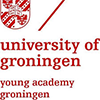
In 2016, Wieling was selected as one of the 18 founding members of the Young Academy of Groningen for a period of five years. The Young Academy Groningen is a club for the University of Groningen’s most talented, enthusiastic and ambitious young researchers. Members come from all fields and disciplines and have a passion for science and an interest in matters concerning science policy, science and society, leadership and career development.
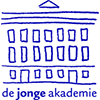
Wieling was selected as one of the youngest members of De Jonge Akademie (DJA) of the Royal Netherlands Academy of Arts and Sciences (KNAW) in April 2015 for a period of five years. In 2018, Wieling was elected as vice-chairman of De Jonge Akademie for a period of two years.The Young Academy is a dynamic and innovative group of 50 top young scientists and scholars with outspoken views about science and scholarship and the related policy. The Young Academy organises inspiring activities for various target groups focusing on interdisciplinarity, science policy, and the interface between science and society.

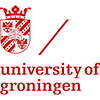


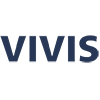

This four-year research grant was awarded to Wieling by the Netherlands Organisation for Scientific Research (NWO) for his project "Improving speech learning models and English pronunciation with articulography". Only 15.5% of the submitted project proposals were granted.

This one-year research grant was awarded to Wieling by the Netherlands Organisation for Scientific Research (NWO) for his project "Investigating language variation physically". Only 12% of the submitted project proposals were granted.
Acoustic-to-articulatory inversion (AAI) is the process of inferring vocal tract movements from acoustic speech signals. Despite its diverse potential applications, AAI research in languages other than English is scarce due to the challenges of collecting articulatory data. In recent years, self-supervised learning (SSL) based representations have shown great potential for addressing low-resource tasks. We utilize wav2vec 2.0 representations and English articulatory data for training AAI systems and investigates their effectiveness for a different language: Dutch. Results show that using mms-1b features can reduce the cross-lingual performance drop to less than 30%. We found that increasing model size, selecting intermediate rather than final layers, and including more pre-training data improved AAI performance. By contrast, fine-tuning on an ASR task did not. Our results therefore highlight promising prospects for implementing SSL in AAI for languages with limited articulatory data.
This study investigates how surgical intervention for speech pathology (specifically, as a result of oral cancer surgery) impacts the performance of an automatic speaker verification (ASV) system. Using two recently collected Dutch datasets with parallel pre and post-surgery audio from the same speaker, NKI-OC-VC and SPOKE, we assess the extent to which speech pathology influences ASV performance, and whether objective/subjective measures of speech severity are correlated with the performance. Finally, we carry out a perceptual study to compare judgements of ASV and human listeners. Our findings reveal that pathological speech negatively affects ASV performance, and the severity of the speech is negatively correlated with the performance. There is a moderate agreement in perceptual and objective scores of speaker similarity and severity, however, we could not clearly establish in the perceptual study, whether the same phenomenon also exists in human perception.
Language questionnaires are often used to approximate the size of linguistic communities, which we attempt for two regional languages in the Netherlands: Frisian and Low Saxon. We distributed a language questionnaire about a range of topics (including language use, proficiency, intergenerational transfer, and the respondent’s language learning context) through an existing large-scale longitudinal study (the Lifelines Cohort Study). This yielded 38,500 respondents across the three northern provinces (Fryslân, Groningen, and Drenthe) where the two regional languages are spoken. Language questionnaires can suffer from bias arising from how questions are presented or information is portrayed. Our sample likely suffered from sampling bias, because the prevalence of dialect speakers was unrealistically large. Initially, we applied post-stratification to account for differences between ratios in the sample and the northern population (e.g., for sex, age, domicile population density, and educational attainment). This only improved the estimates to a limited extent for our metrics (i.e., self-indicated speaking proficiency and use at home), so we used an intergenerational transmission approach instead. Earlier language usage estimates were used as reference points, and we derived estimates for the generations that followed the reference generations. We found that the Low Saxon speaker population size is declining, with around 350,000 speakers in 2021 aged between 6 and 69 (around 41% of the population in that age range) and 140,000 people using it at home (around 17%). The Frisian population appears stable, with around 250,000 speakers aged between 5 and 60 (62% of the population in that age range) and 195,000 people using it at home (around 48%). As these estimates seem plausible when compared to other speaker counts, we conclude that our intergenerational estimation approach may be used to obtain speaker estimates when required information is available and more common methods are ineffective.
In dialectology, the central relationship under investigation is usually that between dialect distance and (Euclidean) geographic distance. Nevertheless, other approaches than geographic distance may be better suited to represent the relationship humans have with space, such as travel times (Gooskens, 2004) or 'rice paddy distances' (Stanford, 2012), and have been successfully used to explain dialect variation. In this study, we explain perceptual dialect differences using both geographic distance and a different type of distance that is commonly used in the field of cognitive geography. Cognitive geography is based on the assumption that an individual's mental representation of their environment has a greater effect on their behaviour than the actual environment (Montello, 2018). A commonly used metric in cognitive geography is the cognitive distance: the geographic distance between two places as estimated by an individual (Montello, 1991). Although the individual and social aspects of language are an important component of research in dialectology, the individual and social aspects of geography have not been widely considered. This study introduces the use of cognitive distances into dialect research and investigates whether these mental representations of space can serve as an explanatory variable in dialectology. Nearly 800 participants from the north of the Netherlands provided cognitive distances between the place where they grew up and seven other locations in the same region. They also rated the similarity of dialect recordings from these locations to the dialect of the location where they grew up. A linear mixed-effects regression model was built to predict perceptual dialect distance from both cognitive distance and geographic distance. The resulting model indicates that geographic distance is more predictive of perceptual dialect distance than cognitive distance. There was also a significant interaction between cognitive and geographic distance. Cognitive distance is more predictive of perceptual dialect distance when geographic distance is short than when geographic distance is long. Furthermore, an exploratory analysis revealed that gender and proficiency in the participants' local dialect were predictive of perceptual dialect distance. Our findings indicate that cognitive distance can be used to explain dialect variation, especially when the area under investigation is small, and consequently that the framework of cognitive geography can be usefully employed in dialectological research.
For many of the world's small languages, few resources are available. In this project, a written online accessible corpus was created for the minority language variant Gronings, which serves both researchers interested in language change and variation and a general audience of (new) speakers interested in finding real-life examples of language use. The corpus was created using a combination of volunteer work and automation, which together formed an efficient pipeline for converting printed text to Key Words in Context (KWICs), annotated with lemmas and part-of-speech tags. In the creation of the corpus, we have taken into account several of the challenges that can occur when creating resources for minority languages, such as a lack of standardisation and limited (financial) resources. As the solutions we offer are applicable to other small languages as well, each step of the corpus creation process is discussed and resources will be made available benefiting future projects on other low-resource languages.
The somatosensory effect of electromagnetic articulography (EMA) sensors on speech remains relatively unexplored. Moreover, EMA sensors may be more disruptive to speech in individuals with somatosensory deficits (e.g., persons with Parkinson's Disease; PwPD). Thus, we investigated the effect of EMA sensors on the articulatory-acoustic vowel space (AAVS) in both typical speakers (n=23) and PwPD (n=23). The AAVS was calculated before EMA sensor placement, directly after, and after approximately one hour to assess habituation. The AAVS significantly decreased following sensor placement and did not change with habituation, regardless of speaker group. PwPD had a smaller AAVS compared to typical speakers, but were not differentially impacted by EMA sensors. EMA sensor placement led to average reductions of the AAVS of 13.5% for PwPD and 14.2% for typical speakers, which suggests that articulatory-acoustics from studies with and without the use of EMA sensors may not be fully comparable.
The impact of surgical treatment for tongue cancer is traditionally assessed with vowel formant metrics from read speech or sustained vowels. However, isolated speech might not fully reflect a speaker's typical speech. Here, we assessed the effect of speaking style (read vs. semi-spontaneous) on vowel acoustics of individuals pre- and post-surgery for tongue cancer. Eight individuals (3 females and 5 males) were recorded pre- and approximately six months post-surgery. We calculated the articulatory-acoustic vowel space (AAVS) during read speech (sentences) and semi-spontaneous speech (picture description). Results showed that the AAVS did not differ significantly pre- and post-surgery. Picture descriptions yielded a significantly smaller AAVS compared to the reading task, which was consistent pre- and post-surgery. Our findings suggest that both read and semi-spontaneous speech styles would be suitable to quantify the impact of surgical intervention for tongue cancer on vowel acoustics.
The goal of this study was to determine whether articulatory-acoustics differ between individuals in the tremor-dominant (TD) and postural instability/gait difficulty (PIGD) phenotypes of Parkinson's disease (PD). The study included 31 individuals with PD (21 TD, 10 PIGD) and 29 control speakers (CS) who were all Dutch native speakers. A read speech task and a semi-spontaneous speech task were completed, and the Articulatory-Acoustic Vowel Space (AAVS) was calculated for both tasks. Results showed no significant difference in AAVS between the overall control group and PD for either phenotype. Follow-up analyses, pooling speech data from our prior study (+27 PD, +23 CS), demonstrated a significantly lower AAVS in males with PD compared to controls and no group differences for females. Thus, articulatory-acoustic changes may be more pronounced for male compared to female speakers with PD, but may not differ by PD phenotype.
The syllabic liquids [ɚ] (as in "purr") and [əɫ] (as in "pull") have well-defined acoustic targets but are produced with a wide range of heterogenous tongue postures. This work surveys midsagittal tongue shapes from a large (N=78) number of speakers producing these sounds, to illustrate their variety, and to determine systematically how this variety can be quantified. In particular we propose that a categorization based on just two parameters--degree of tongue dorsum convexity and tip orientation--is sufficient to classify observed shapes, and superior to defining ad hoc prototypes.
Belonging to groups is often based on shared features between members and is associated with higher levels of (social) well-being. One especially strong marker of one's group membership is language. In linguistics, most research about group membership and well-being focuses on migrants and refugees. However, very little research has focused on the link between speaking a regional language and well-being. This is surprising, as regional languages index a strong shared in-group identity that could lead to exclusion of those who do not speak them. As a first empirical step, this paper reports on the association between regional language use (specifically, of Frisian and Low Saxon) and social well-being. We distributed a language background questionnaire to participants of the Lifelines cohort, a multigenerational cohort study comprising data from 167,729 participants living in the north of the Netherlands. In both language contexts (Frisian in Fryslân, and Low Saxon in Groningen and Drenthe), those using the regional language half of the time or more were found to have significantly more social contacts. They also experienced higher levels of social embeddedness than those who did not know or did not frequently use the regional language. The higher degree of social embeddedness for frequent regional language users was most strongly present in rural areas. Furthermore, we found that frequent users of Frisian living in Fryslân had higher levels of social embeddedness in rural areas than frequent users of Low Saxon living in Groningen or Drenthe. No effect was found for more overt measures of social well-being such as loneliness or life satisfaction. While our results confirm an association between regional language speaking and some indices of social functioning on a large scale, they cannot uncover a causal relationship between the two. We discuss how longitudinal studies and interviews in future studies may inform us further about the relation between regional language use and social well-being.
ERPs (Event-Related Potentials) have become a widely-used measure to study second language (L2) processing. To study individual differences, traditionally a component outcome measure is calculated by averaging the amplitude of a participant's brain response in a pre-specified time window of the ERP waveform in different conditions (e.g., the 'Response Magnitude Index'; Tanner, Mclaughlin, Herschensohn & Osterhout, 2013). This approach suffers from the problem that the definition of such time windows is rather arbitrary, and that the result is sensitive to outliers as well as participant variation in latency. The latter is particularly problematic for studies on L2 processing. Furthermore, the size of the ERP response (i.e., amplitude difference) of an L2 speaker may not be the best indicator of near-native proficiency, as native speakers also show a great deal of variability in this respect, with the 'robustness' of an L2 speaker's ERP response (i.e., how consistently they show an amplitude difference) potentially being a more useful indicator. In this paper we introduce a novel method for the extraction of a set of individual difference measures from ERP waveforms. Our method is based on participants' complete waveforms for a given time series, modelled using generalized additive modelling (GAM; Wood, 2017). From our modelled waveform, we extract a set of measures which are based on amplitude, area and peak effects. We illustrate the benefits of our method compared to the traditional Response Magnitude Index with data on the processing of grammatical gender violations in 66 Slavic L2 speakers of German and 29 German native speakers. One of our measures in particular appears to outperform the others in characterizing differences between native speakers and L2 speakers, and captures proficiency differences between L2 speakers: the 'Normalized Modelled Peak'. This measure reflects the height of the (modelled) peak, normalized against the uncertainty of the modelled signal, here in the P600 search window. This measure may be seen as a measure of peak robustness, that is, how reliable the individual is able to show a P600 effect, largely independently of where in the P600 window this occurs. We discuss implications of our results and offer suggestions for future studies on L2 processing. The code to implement these analyses is available for other researchers.
Large phonetic corpora are frequently used to investigate language variation and change in dialects, but these corpora are often constructed by many researchers in a collaborative effort. This typically results in inter-transcriber issues that may impact the reliability of analyses using these data. This problem is exacerbated when multiple phonetic corpora are compared when investigating real time dialect change. In this study, we therefore propose a method to automatically and iteratively merge phonetic symbols used in the transcriptions to obtain a more course-grained, but better comparable, phonetic transcription. Our approach is evaluated using two large phonetic Netherlandic dialect corpora in an attempt to estimate sound change in the area in the 20th century. The results are discussed in the context of the available literature about dialect change in the Netherlandic area.
We investigate the usage of auxiliary and modal verbs in Low Saxon dialects from both Germany and the Netherlands based on word vectors, and compare developments in the modern language to Middle Low Saxon. Although most of these function words have not been affected by lexical replacement, changes in usage that likely at least partly result from contact with the state languages can still be observed.
With the ever-growing accessibility of case law online, it has become challenging to manually identify case law relevant to one's legal issue. In the Netherlands, the planned increase in the online publication of case law is expected to exacerbate this challenge. In this paper, we tried to predict whether court decisions are cited by other courts or not after being published, thus in a way distinguishing between more and less authoritative cases. This type of system may be used to process the large amounts of available data by filtering out large quantities of non-authoritative decisions, thus helping legal practitioners and scholars to find relevant decisions more easily, and drastically reducing the time spent on preparation and analysis. For the Dutch Supreme Court, the match between our prediction and the actual data was relatively strong (with a Matthews Correlation Coefficient of 0.60). Our results were less successful for the Council of State and the district courts (MCC scores of 0.26 and 0.17, relatively). We also attempted to identify the most informative characteristics of a decision. We found that a completely explainable model, consisting only of handcrafted metadata features, performs almost as well as a less well-explainable system based on all text of the decision.
The performance of automatic speech recognition (ASR) systems has advanced substantially in recent years, particularly for languages for which a large amount of transcribed speech is available. Unfortunately, for low-resource languages, such as minority languages, regional languages or dialects, ASR performance generally remains much lower. In this study, we investigate whether data augmentation techniques could help improve low-resource ASR performance, focusing on four typologically diverse minority languages or language variants (West Germanic: Gronings, West-Frisian; Malayo-Polynesian: Besemah, Nasal). For all four languages, we examine the use of self-training, where an ASR system trained with the available human-transcribed data is used to generate transcriptions, which are then combined with the original data to train a new ASR system. For Gronings, for which there was a pre-existing text-to-speech (TTS) system available, we also examined the use of TTS to generate ASR training data from text-only sources. We find that using a self-training approach consistently yields improved performance (a relative WER reduction up to 20.5% compared to using an ASR system trained on 24 minutes of manually transcribed speech). The performance gain from TTS augmentation for Gronings was even stronger (up to 25.5% relative reduction in WER compared to a system based on 24 minutes of manually transcribed speech). In sum, our results show the benefit of using self-training or (if possible) TTS-generated data as an efficient solution to overcome the limitations of data availability for resource-scarce languages in order to improve ASR performance.
We introduce the Dutch Model Benchmark: DUMB. The benchmark includes a diverse set of datasets for low-, medium- and high-resource tasks. The total set of nine tasks includes four tasks that were previously not available in Dutch. Instead of relying on a mean score across tasks, we propose Relative Error Reduction (RER), which compares the DUMB performance of language models to a strong baseline which can be referred to in the future even when assessing different sets of language models. Through a comparison of 14 pre-trained language models (mono- and multi-lingual, of varying sizes), we assess the internal consistency of the benchmark tasks, as well as the factors that likely enable high performance. Our results indicate that current Dutch monolingual models under-perform and suggest training larger Dutch models with other architectures and pre-training objectives. At present, the highest performance is achieved by DeBERTaV3 (large), XLM-R (large) and mDeBERTaV3 (base). In addition to highlighting best strategies for training larger Dutch models, DUMB will foster further research on Dutch. A public leaderboard is available at https://dumbench.nl.
The study investigates whether a short formant perturbation experiment elicits an adaptive response under less controlled experimental circumstances. 30 Dutch children were recruited and tested at a festival. They were asked to produce four target words containing an open-mid front rounded vowel /ɛ/ while we manipulated their feedback so that they would hear /ɪ/ for a period of 16 trials. Despite the short adaptation paradigm, our results show that children significantly changed their vowel productions in response to the perturbation. This suggests that long and monotonous experimental paradigms might not always be necessary, especially with populations that have a shorter attention span.
In this paper, we discuss the specifications of a mobile laboratory, dubbed SPRAAKLAB, and how we use it for acquiring research-grade acoustic and articulatory data in the field, thereby providing access to participant populations which are otherwise hard to study. In addition, we illustrate how the mobile laboratory supports public engagement activities in combination with research data acquisition, allowing us to entertain and inform an interested audience about speech research, while simultaneously collecting speech production data from dozens of participants in a matter of days.
This article reports investigations into sound change at the community-level of Frisian and Low Saxon dialect groups in the north of the Netherlands, which differ in key factors influencing dialect decline. We combine phoneti- cally transcribed corpora with dialectometric approaches that can quantify change among older male dialect speakers in a real-time framework. A multidimensional variant of the Levenshtein distance, combined with methods that induce realistic distances between sounds, is used to estimate how much dialect groups converged to and diverged from Standard Dutch between 1990 and 2010. Our analyses indicate that sound change is a slow process in this geographical area. The Frisian and North Low Saxon dialect groups seem to be most stable, while Westphalian Low Saxon varieties seem to be most prone to change. We offer possible explanations for our findings and discuss shortcomings of the data and approach in detail.
Background: The pandemic of the coronavirus disease 2019 (COVID-19) has led to an increased burden on mental health. Aims: To investigate the development of major depressive disorder (MDD), generalized anxiety disorder (GAD), and suicidal ideation in the Netherlands during the first fifteen months of the pandemic and three nation-wide lockdowns.
Method: Participants of the Lifelines Cohort Study - a Dutch population-based sample-reported current symptoms of MDD and GAD, including suicidal ideation, according to DSM-IV criteria. Between March 2020 and June 2021, 36,106 participants (aged 18-96) filled out a total of 629,811 questionnaires across 23 time points. Trajectories over time were estimated using generalized additive models and analyzed in relation to age, sex, and lifetime history of MDD/GAD.
Results: We found non-linear trajectories for MDD and GAD with a higher number of symptoms and prevalence rates during periods of lockdown. The point prevalence of MDD and GAD peaked during the third hard lockdown at 2.88 % (95 % CI: 2.71 %-3.06 %) and 2.92 % (95 % CI: 2.76 %-3.08 %), respectively, in March 2021. Women, younger adults, and participants with a history of MDD/GAD reported significantly more symptoms. For suicidal ideation, we found a significant linear increase over time in younger participants. For example, 20-year-old participants reported 4.14x more suicidal ideation at the end of June 2021 compared to the start of the pandemic (4.64 % (CI: 3.09 %-6.96 %) versus 1.12 % (CI: 0.76 %-1.66 %)).
Limitations: Our findings should be interpreted in relation to the societal context of the Netherlands and the public health response of the Dutch government during the pandemic, which may be different in other regions in the world.
Conclusions: Our study showed greater prevalence of MDD and GAD during COVID-19 lockdowns and a continuing increase in suicidal thoughts among young adults suggesting that the pandemic and government enacted restrictions impacted mental health in the population. Our findings provide actionable insights on mental health in the population during the pandemic, which can guide policy makers and clinical care during future lockdowns and epi/pandemics.
The present study examined the kinematics of maximal effort sprint running, mapping the relations among a person's maximal running speed, maximum running acceleration and the distance coverable in a certain amount of time by this person. Thirty-three participants were recruited to perform a simple sprint task. Both forward and backward running were considered. Participants' position, velocity and acceleration data were obtained using a Local Positioning Measurement system. Participants' speed-acceleration profiles turned out to be markedly non-linear. To account for these non-linear patterns, we propose a new macroscopic model on the kinematics of sprint running. Second, we examined whether target distance was of influence on the evolution of participants' running speeds over time. Overall, no such effect on running velocity was present, except for a 'finish-line effect'. Finally, we studied how variation in individuals' maximum running velocities and accelerations related to differences in their action boundaries. The findings are discussed in the context of affordance-based control in running to catch fly balls.
Although communicative language teaching (CLT) was thought to have revolutionized classroom practice, there are "weak" and "strong" versions (Howatt, 1984). Most foreign language classrooms in the world still favor weak versions with structure-based (SB) views on language (Lightbown & Spada, 2013), and practice in the Netherlands is not much different (West & Verspoor, 2016). However, a small group of teachers in the Netherlands started teaching French as a second language with a strong CLT program in line with Dynamic Usage-Based (DUB) principles. Rather than focusing on rule learning and explicit grammar teaching to avoid errors, the DUB program takes the dynamics of second-language development into consideration and focuses on the three key elements of usage-based theory: frequency, salience and contingency. These translate into a great deal of exposure, repetition, learning the meaning of every single word through gestures, and presenting whole chunks of language, all without explicit grammar teaching. This study aims to compare the effects of the SB and DUB instructional programs after three years. We traced the second-language development of 229 junior high school students (aged 12 to 15) learning French in the Netherlands over three years. The participants took three oral tests over the course of three years (568 interviews) and wrote seven narratives on the same topic (1511 narratives). As expected, the DUB approach, which is in line with a strong CLT version, was more effective in achieving proficiency in both speaking and writing and equally effective in achieving accuracy.
Deep acoustic models represent linguistic information based on massive amounts of data. Unfortunately, for regional languages and dialects such resources are mostly not available. However, deep acoustic models might have learned linguistic information that transfers to low-resource languages. In this study, we evaluate whether this is the case through the task of distinguishing low-resource (Dutch) regional varieties. By extracting embeddings from the hidden layers of various wav2vec 2.0 models (including a newly created Dutch model) and using dynamic time warping, we compute pairwise pronunciation differences averaged over 10 words for over 100 individual dialects from four (regional) languages. We then cluster the resulting difference matrix in four groups and compare these to a gold standard, and a partitioning on the basis of comparing phonetic transcriptions. Our results show that acoustic models outperform the (traditional) transcription-based approach without requiring phonetic transcriptions, with the best performance achieved by the multilingual XLSR-53 model fine-tuned on Dutch. On the basis of only six seconds of speech, the resulting clustering closely matches the gold standard.
Cross-lingual transfer learning with large multilingual pre-trained models can be an effective approach for low-resource languages with no labeled training data. Existing evaluations of zero-shot cross-lingual generalisability of large pre-trained models use datasets with English training data, and test data in a selection of target languages. We explore a more extensive transfer learning setup with 65 different source languages and 105 target languages for part-of-speech tagging. Through our analysis, we show that pre-training of both source and target language, as well as matching language families, writing systems, word order systems, and lexical-phonetic distance significantly impact cross-lingual performance. The findings described in this paper can be used as indicators of which factors are important for effective zero-shot cross-lingual transfer to zero- and low-resource languages.
We compare five Low Saxon dialects from the 19th and 21st century from Germany and the Netherlands with each other as well as with modern Standard Dutch and Standard German. Our comparison is based on character n-grams on the one hand and PoS n-grams on the other and we show that these two lead to different distances. Particularly in the PoS-based distances, one can observe all of the 21st century Low Saxon dialects shifting towards the modern majority languages.
Variation in speech is often quantified by comparing phonetic transcriptions of the same utterance. However, manually transcribing speech is time-consuming and error prone. As an alternative, therefore, we investigate the extraction of acoustic embeddings from several self-supervised neural models. We use these representations to compute word-based pronunciation differences between non-native and native speakers of English, and between Norwegian dialect speakers. For comparison with several earlier studies, we evaluate how well these differences match human perception by comparing them with available human judgements of similarity. We show that speech representations extracted from a specific type of neural model (i.e.~Transformers) lead to a better match with human perception than two earlier approaches on the basis of phonetic transcriptions and MFCC-based acoustic features. We furthermore find that features from the neural models can generally best be extracted from one of the middle hidden layers than from the final layer. We also demonstrate that neural speech representations not only capture segmental differences, but also intonational and durational differences that cannot adequately be represented by a set of discrete symbols used in phonetic transcriptions.
In this paper, we discuss previous research in automatic prediction of court decisions. We define the difference between outcome identification, outcome-based judgement categorisation and outcome forecasting, and review how various studies fall into these categories. We discuss how important it is to understand the legal data that one works with in order to determine which task can be performed. Finally, we reflect on the needs of the legal discipline regarding the analysis of court judgements.
In this paper we attempt to identify eviction judgements within all case law published by Dutch courts in order to automate data collection, previously conducted manually. To do so we performed two experiments. The first focused on identifying judgements related to eviction, while the second focused on identifying the outcome of the cases in the judgements (eviction vs.~dismissal of the landlord's claim). In the process of conducting the experiments for this study, we have created a manually annotated dataset with eviction-related judgements and their outcomes.
Second language (L2) learning has been promoted as a promising intervention to stave off age-related cognitive decline. While previous studies based on mean trends showed inconclusive results, this study is the first to investigate nonlinear cognitive trajectories across a 30-week training period. German-speaking older participants (aged 64-75 years) enrolled for a Spanish course, strategy game training (active control) or movie screenings (passive control). We assessed cognitive performance in working memory, alertness, divided attention and verbal fluency on a weekly basis. Trajectories were modelled using Generalized Additive Mixed Models to account for temporally limited transfer effects and intraindividual variation in cognitive performance. Our results provide no evidence of cognitive improvement differing between the Spanish and either of the control groups during any phase of the training period. We did, however, observe an effect of baseline cognition, such that individuals with low cognitive baselines increased their performance more in the L2 group than comparable individuals in the control groups. We discuss these findings against the backdrop of the cognitive training literature and Complex Dynamic Systems Theory.
Purpose: This study compares two electromagnetic articulographs (EMA) manufactured by Northern Digital, Inc.: the NDI Wave System (2008) and the NDI Vox-EMA System (2020).
Method: Four experiments were completed: (a) comparison of statically positioned sensors; 4(b) tracking dynamic movements of sensors manipulated using a motor-driven LEGO apparatus; (c) tracking small and large movements of sensors mounted in a rigid bar manipulated by hand; and (d) tracking movements of sensors rotated on a circular disc. We assessed spatial variability for statically positioned sensors, variability in the transduced Euclidean distances (EDs) between sensor pairs, and missing data rates. For sensors tracking circular movements, we compared the fit between fitted ideal circles and actual trajectories.
Results: The average sensor pair tracking error (i.e., the standard deviation of the EDs) was 1.37 mm for the WAVE and 0.12 mm for the VOX during automated trials at the fastest speed, and 0.35 mm for the WAVE and 0.14mm for the VOX during the tracking of large manual movements. The average standard deviation of the fitted circle radii charted by manual circular disc movements was 0.72mm for the WAVE sensors and 0.14mm for the VOX sensors. There was no significant difference between the WAVE and the VOX in the number of missing frames.
Conclusions: In general, the VOX system significantly outperformed the WAVE on measures of both static precision and dynamic accuracy (automated and manual). For both systems, positional precision and spatial variability were influenced by the sensors' position relative to the field generator unit (FGU; worse when further away).
Judicial decision classification using Natural Language Processing and machine learning has received much attention in the last decade. While many studies claim to 'predict judicial decisions', most of them only classify already made judgements. Likely due to the lack of data, there have been only a few studies that discuss the data and the methods to forecast future judgements of the courts on the basis of data available before the court judgement is known. Besides proposing a more consistent and precise terminology, as classification and forecasting each have different uses and goals, we release a first benchmark dataset consisting of documents of the European Court of Human Rights to address this task. The dataset includes raw data as well as pre-processed text of final judgements, admissibility decisions and communicated cases. The latter are published by the Court for pending applications (generally) many years before the case is judged, allowing one to forecast judgements for pending cases. We establish a baseline for this task and illustrate that it is a much harder task than simply classifying judgements.
For many (minority) languages, the resources needed to train large models are not available. We investigate the performance of zero-shot transfer learning with as little data as possible, and the influence of language similarity in this process. We retrain the lexical layers of four BERT-based models using data from two low-resource target language varieties, while the Transformer layers are independently fine-tuned on a POS-tagging task in the model's source language. By combining the new lexical layers and fine-tuned Transformer layers, we achieve high task performance for both target languages. With high language similarity, 10MB of data appears sufficient to achieve substantial monolingual transfer performance. Monolingual BERT-based models generally achieve higher downstream task performance after retraining the lexical layer than multilingual BERT, even when the target language is included in the multilingual model.
This paper reviews data collection practices in electromagnetic articulography (EMA) studies, with a focus on sensor placement. It consists of three parts: in the first part, we introduce electromagnetic articulography as a method. In the second part, we focus on existing data collection practices. Our overview is based on a literature review of 905 publications from a large variety of journals and conferences, identified through a systematic keyword search in Google Scholar. The review shows that experimental designs vary greatly, which in turn may limit researchers' ability to compare results across studies. In the third part of this paper we describe an EMA data collection procedure which includes an articulatory-driven strategy for determining where to position sensors on the tongue without causing discomfort to the participant. We also evaluate three approaches for preparing (NDI Wave) EMA sensors reported in the literature with respect to the duration the sensors remain attached to the tongue: 1) attaching out-of-the-box sensors, 2) attaching sensors coated in latex, and 3) attaching sensors coated in latex with an additional latex flap. Results indicate no clear general effect of sensor preparation type on adhesion duration. A subsequent exploratory analysis reveals that sensors with the additional flap tend to adhere for shorter times than the other two types, but that this pattern is inverted for the most posterior tongue sensor.
Background: Most epidemiological studies show a decrease of internalizing disorders at older ages, but it is unclear how the prevalence exactly changes with age, and whether there are different patterns for internalizing symptoms and traits, and for men and women. This study investigates the impact of age and sex on the point prevalence across different mood and anxiety disorders, internalizing symptoms, and neuroticism.
Methods: We used cross-sectional data on 146,315 subjects, aged 18-80 years, from the Lifelines Cohort Study, a Dutch general population sample. Between 2012-2016, five current internalizing disorders - major depression, dysthymia, generalized anxiety disorder, social phobia and panic disorder - were assessed according to DSM-IV criteria. Depressive symptoms, anxiety symptoms, neuroticism, and negative affect were also measured. Generalized additive models were used to identify nonlinear patterns of internalizing disorders, symptoms and traits over lifetime, and to investigate sex differences.
Results: The point prevalence of internalizing disorders generally increased between the ages of 18-30 years, stabilized between 30-50, and decreased after age 50. The patterns of internalizing symptoms and traits were different. Negative affect and neuroticism gradually decreased after age 18. Women reported more internalizing disorders than men, but the relative difference remained stable across age (relative risk ~1.7).
Conclusions: The point prevalence of internalizing disorders was typically highest between age 30-50, but there were differences between the disorders, which could indicate differences in etiology. The relative gap between the sexes remained similar across age, suggesting that changes in sex hormones around the menopause do not significantly influence women's risk of internalizing disorders.
In this paper we present the web platform JURI SAYS that automatically predicts decisions of the European Court of Human Rights based on communicated cases, which are published by the court early in the proceedings and are often available many years before the final decision is made. Our system therefore predicts future judgements of the court. The platform is available at jurisays.com and shows the predictions compared to the actual decisions of the court. It is automatically updated every month by including the prediction for the new cases. Additionally, the system highlights the sentences and paragraphs that are most important for the prediction (i.e. violation vs. no violation of human rights).
We present a new comprehensive dataset for the unstandardised West-Germanic language Low Saxon covering the last two centuries, the majority of modern dialects and various genres, which will be made openly available in connection with the final version of this paper. Since so far no such comprehensive dataset of contemporary Low Saxon exists, this provides a great contribution to NLP research on this language. We also test the use of this dataset for dialect classification by training a few baseline models comparing statistical and neural approaches. The performance of these models shows that in spite of an imbalance in the amount of data per dialect, enough features can be learned for a relatively high classification accuracy.
Alcohol intoxication is known to affect many aspects of human behavior and cognition; one of such affected systems is articulation during speech production. Although much research has revealed that alcohol negatively impacts pronunciation in a first language (L1), there is only initial evidence suggesting a potential beneficial effect of inebriation on articulation in a non-native language (L2). The aim of this study was thus to compare the effect of alcohol consumption on pronunciation in an L1 and an L2. Participants who had ingested different amounts of alcohol provided speech samples in their L1 (Dutch) and L2 (English), and native speakers of each language subsequently rated the pronunciation of these samples on their intelligibility (for the L1) and accent nativelikeness (for the L2). These data were analyzed with generalized additive mixed modeling. Participants' blood alcohol concentration indeed negatively affected pronunciation in L1, but it produced no significant effect on the L2 accent ratings. The expected negative impact of alcohol on L1 articulation can be explained by reduction in fine motor control. We present two hypotheses to account for the absence of any effects of intoxication on L2 pronunciation: (i) there may be a reduction in L1 interference on L2 speech due to decreased motor control or (ii) alcohol may produce a differential effect on each of the two linguistic subsystems.
We present an acoustic distance measure for comparing pronunciations, and apply the measure to assess foreign accent strength in American-English by comparing speech of non-native American-English speakers to a collection of native American-English speakers. An acoustic-only measure is valuable as it does not require the time-consuming and error-prone process of phonetically transcribing speech samples which is necessary for current edit distance-based approaches. We minimize speaker variability in the data set by employing speaker-based cepstral mean and variance normalization, and compute word-based acoustic distances using the dynamic time warping algorithm. Our results indicate a strong correlation of r = -0.71 (p < 0.0001) between the acoustic distances and human judgments of native-likeness provided by more than 1,100 native American-English raters. Therefore, the convenient acoustic measure performs only slightly lower than the state-of-the-art transcription-based performance of r = -0.77. We also report the results of several small experiments which show that the acoustic measure is not only sensitive to segmental differences, but also to intonational differences and durational differences. However, it is not immune to unwanted differences caused by using a different recording device.
When courts started publishing judgements, big data analysis (i.e. largescale statistical analysis of case law and machine learning) within the legal domain became possible. By taking data from the European Court of Human Rights as an example, we investigate how Natural Language Processing tools can be used to analyse texts of the court proceedings in order to automatically predict (future) judicial decisions. With an average accuracy of 75% in predicting the violation of 9 articles of the European Convention on Human Rights our (relatively simple) approach highlights the potential of machine learning approaches in the legal domain. We show, however, that predicting decisions for future cases based on the cases from the past negatively impacts performance (average accuracy range from 58% to 68%). Furthermore, we demonstrate that we can achieve a relatively high classification performance (average accuracy of 65%) when predicting outcomes based only on the surnames of the judges that try the case.
This study focuses on an essential precondition for reproducibility in computational linguistics: the willingness of authors to share relevant source code and data. Ten years after Ted Pedersen's influential ``Last Words'' contribution in Computational Linguistics, we investigate to what extent researchers in computational linguistics are willing and able to share their data and code. We surveyed all 395 full papers presented at the 2011 and 2016 ACL Annual Meetings, and identified if links to data and code were provided. If working links were not provided, authors were requested to provide this information. While data was often available, code was shared less often. When working links to code or data were not provided in the paper, authors provided the code in about one third of cases. For a selection of ten papers, we attempted to reproduce the results using the provided data and code. We were able to reproduce the results approximately for half of the papers. For only a single paper we obtained the exact same results. Our findings show that even though the situation appears to have improved comparing 2016 to 2011, empiricism in computational linguistics still largely remains a matter of faith (Pedersen, 2008). Nevertheless, we are somewhat optimistic about the future. Ensuring reproducibility is not only important for the field as a whole, but also for individual researchers: below we show that the median citation count for studies with working links to the source code are higher.
We conduct the first experiment in the literature in which a novel is translated automatically and then post-edited by professional literary translators. Our case study is Warbreaker, a popular fantasy novel originally written in English, which we translate into Catalan. We translated one chapter of the novel (over 3,700 words, 330 sentences) with two data-driven approaches to Machine Translation (MT): phrase-based statistical MT (PBMT) and neural MT (NMT). Both systems are tailored to novels; they are trained on over 100 million words of fiction. In the post-editing experiment, six professional translators with previous experience in literary translation translate subsets of this chapter under three alternating conditions: from scratch (the norm in the novel translation industry), post-editing PBMT, and post-editing NMT. We record all the keystrokes, the time taken to translate each sentence, as well as the number of pauses and their duration. Based on these measurements, and using mixed-effects models, we study post-editing effort across its three commonly studied dimensions: temporal, technical and cognitive. We observe that both MT approaches result in increases in translation productivity: PBMT by 18%, and NMT by 36%. Post-editing also leads to reductions in the number of keystrokes: by 9% with PBMT, and by 23% with NMT. Finally, regarding cognitive effort, post-editing results in fewer (29% and 42% less with PBMT and NMT respectively) but longer pauses (14% and 25%).
In phonetics, many datasets are encountered which deal with dynamic data collected over time. Examples include diphthongal formant trajectories and articulator trajectories observed using electromagnetic articulography. Traditional approaches for analyzing this type of data generally aggregate data over a certain timespan, or only include measurements at a fixed time point (e.g., formant measurements at the midpoint of a vowel). In this paper, I discuss generalized additive modeling, a non-linear regression method which does not require aggregation or the pre-selection of a fixed time point. Instead, the method is able to identify general patterns over dynamically varying data, while simultaneously accounting for subject and item-related variability. An advantage of this approach is that patterns may be discovered which are hidden when data is aggregated or when a single time point is selected. A corresponding disadvantage is that these analyses are generally more time consuming and complex. This tutorial aims to overcome this disadvantage by providing a hands-on introduction to generalized additive modeling using articulatory trajectories from L1 and L2 speakers of English within the freely available R environment. All data and R code is made available to reproduce the analysis presented in this paper.
In this study, we investigate crosslinguistic patterns in the alternation between UM, a hesitation marker consisting of a neutral vowel followed by a final labial nasal, and UH, a hesitation marker consisting of a neutral vowel in an open syllable. Based on a quantitative analysis of a range of spoken and written corpora, we identify clear and consistent patterns of change in the use of these forms in various Germanic languages (English, Dutch, German, Norwegian, Danish, Faroese) and dialects (American English, British English), with the use of UM increasing over time relative to the use of UH. We also find that this pattern of change is generally led by women and more educated speakers. Finally, we propose a series of possible explanations for this surprising change in hesitation marker usage that is currently taking place across Germanic languages.
The present study uses electromagnetic articulography, by which the position of tongue and lips during speech is measured, for the study of dialect variation. By using generalized additive modeling to analyze the articulatory trajectories, we are able to reliably detect aggregate group differences, while simultaneously taking into account the individual variation of dozens of speakers. Our results show that two Dutch dialects show clear differences in their articulatory settings, with generally a more anterior tongue position in the dialect from Ubbergen in the southern half of the Netherlands than in the dialect of Ter Apel in the northern half of the Netherlands. A comparison with formant-based acoustic measurements further reveals that articulography is able to reveal interesting structural articulatory differences between dialects which are not visible when only focusing on the acoustic signal.
In this study we investigate the effect of age of acquisition (AoA) on grammatical processing in second language learners as measured by event-related brain potentials (ERPs). We compare a traditional analysis involving the calculation of averages across a certain time window of the ERP waveform, analyzed with categorical groups (early vs. late), with a generalized additive modeling analysis, which allows us to take into account the full range of variability in both AoA and time. Sixty-six Slavic advanced learners of German listened to German sentences with correct and incorrect use of non-finite verbs and grammatical gender agreement. We show that the ERP signal depends on the AoA of the learner, as well as on the regularity of the structure under investigation. For gender agreement, a gradual change in processing strategies can be shown that varies by AoA, with younger learners showing a P600 and older learners showing a posterior negativity. For verb agreement, all learners show a P600 effect, irrespective of AoA. Based on their behavioral responses in an offline grammaticality judgment task, we argue that the late learners resort to computationally less efficient processing strategies when confronted with (lexically determined) syntactic constructions different from the L1. In addition, this study highlights the insights the explicit focus on the time course of the ERP signal in our analysis framework can offer compared to the traditional analysis.
Dialectometry applies computational and statistical analyses within dialectology, making work more easily replicable and understandable. This survey article first reviews the field briefly in order to focus on developments in the past five years. Dialectometry no longer focuses exclusively on aggregate analyses, but rather deploys various techniques to identify representative and distinctive features with respect to areal classifications. Analyses proceeding explicitly from geostatistical techniques have just begun. The exclusive focus on geography as explanation for variation has given way to analyses combining geographical, linguistic, and social factors underlying language variation. Dialectometry has likewise ventured into diachronic studies and has also contributed theoretically to comparative dialectology and the study of dialect diffusion. Although the bulk of research involves lexis and phonology, morphosyntax is receiving increasing attention. Finally, new data sources and new (online) analytical software are expanding dialectometry's remit and its accessibility.
This study uses a generalized additive mixed-effects regression model to predict lexical differences in Tuscan dialects with respect to standard Italian. We used lexical information for 170 concepts used by 2,060 speakers in 213 locations in Tuscany. In our model, geographical position was found to be an important predictor, with locations more distant from Florence having lexical forms more likely to differ from standard Italian. In addition, the geographical pattern varied significantly for low- versus high-frequency concepts and older versus younger speakers. Younger speakers generally used variants more likely to match the standard language. Several other factors emerged as significant. Male speakers as well as farmers were more likely to use lexical forms different from standard Italian. In contrast, higher-educated speakers used lexical forms more likely to match the standard. The model also indicates that lexical variants used in smaller communities are more likely to differ from standard Italian. The impact of community size, however, varied from concept to concept. For a majority of concepts, lexical variants used in smaller communities are more likely to differ from the standard Italian form. For a minority of concepts, however, lexical variants used in larger communities are more likely to differ from standard Italian. Similarly, the effect of the other community- and speaker-related predictors varied per concept. These results clearly show that the model succeeds in teasing apart different forces influencing the dialect landscape and helps us to shed light on the complex interaction between the standard Italian language and the Tuscan dialectal varieties. In addition, this study illustrates the potential of generalized additive mixed-effects regression modeling applied to dialect data.
I frequently teach (invited) statistics courses for linguists focusing on generalized additive modeling.This technique, which is also able to take into account subject- and item-related variability (i.e. similar to mixed-effects regression) is important as it allows to model complex non-linear relationships between predictors and the dependent variable (e.g., time-series data such as EEG data). I've been invited to teach these courses at (e.g.,) Cambridge, Montréal and Toulouse. Slides (which are regularly updated) of these courses can be found here. If you are interested in this type of statistics course (generally ranging from two to five days), you are welcome to contact me. Note that I do ask a fee for teaching these courses.
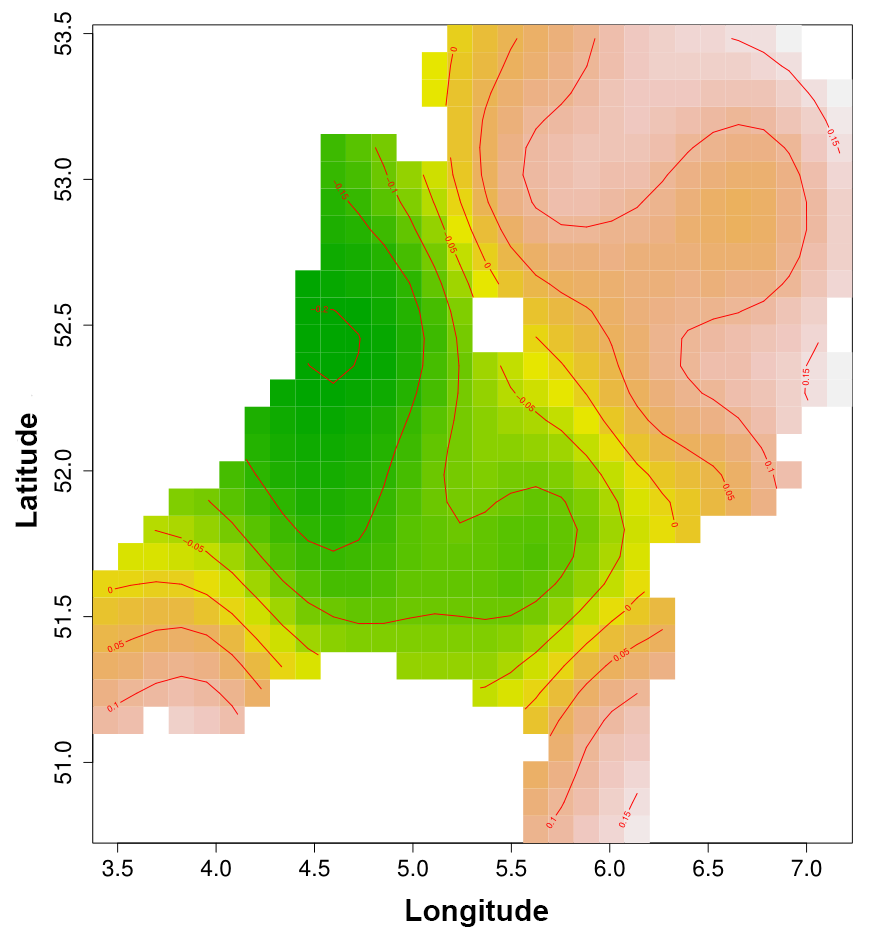
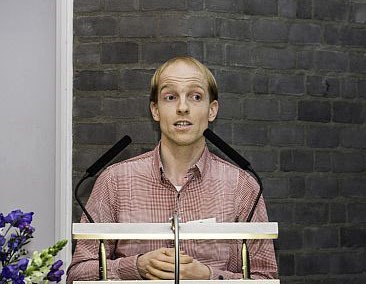
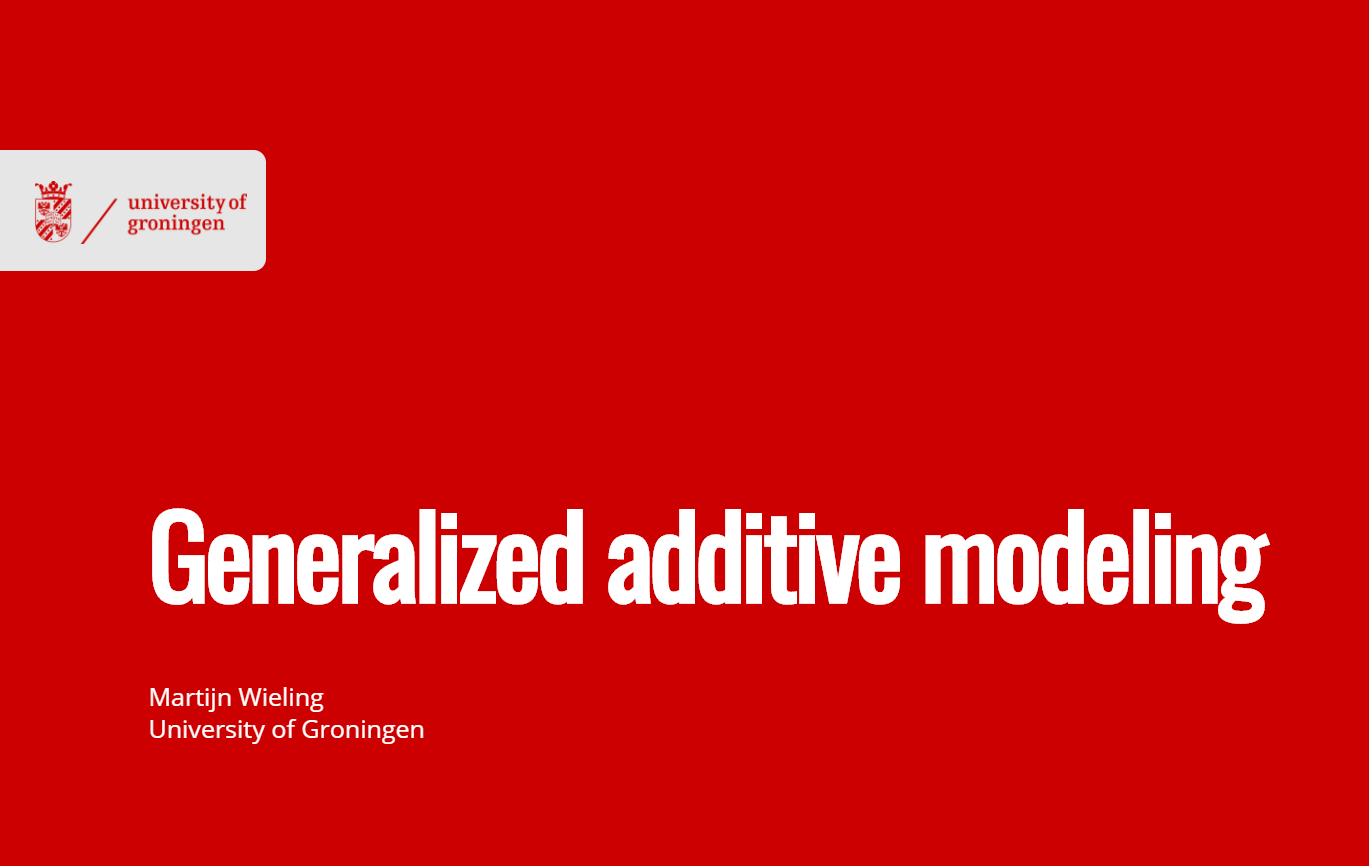
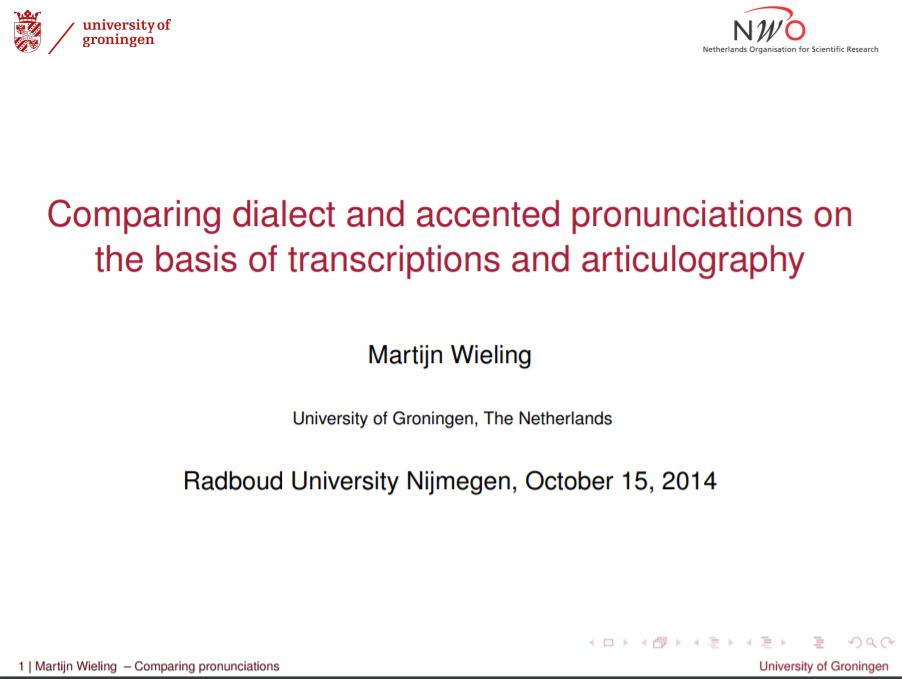
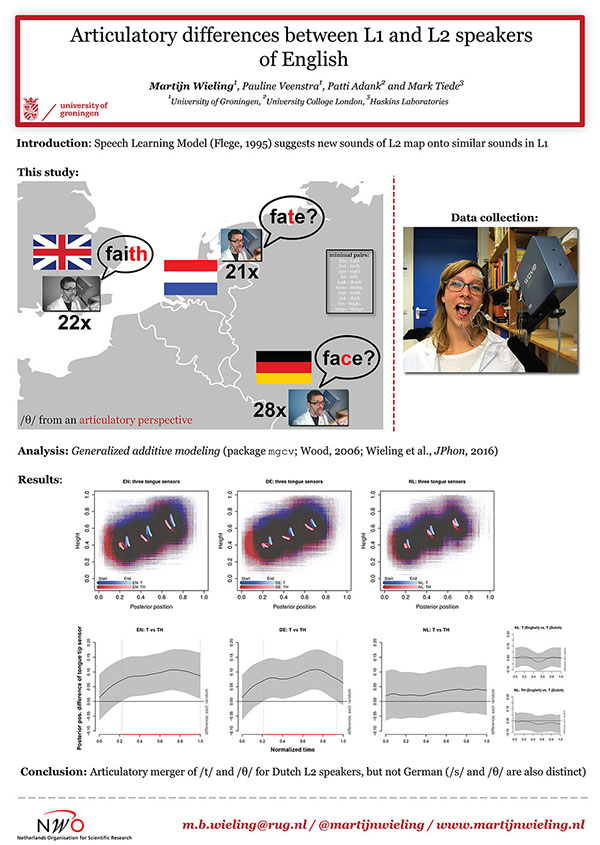

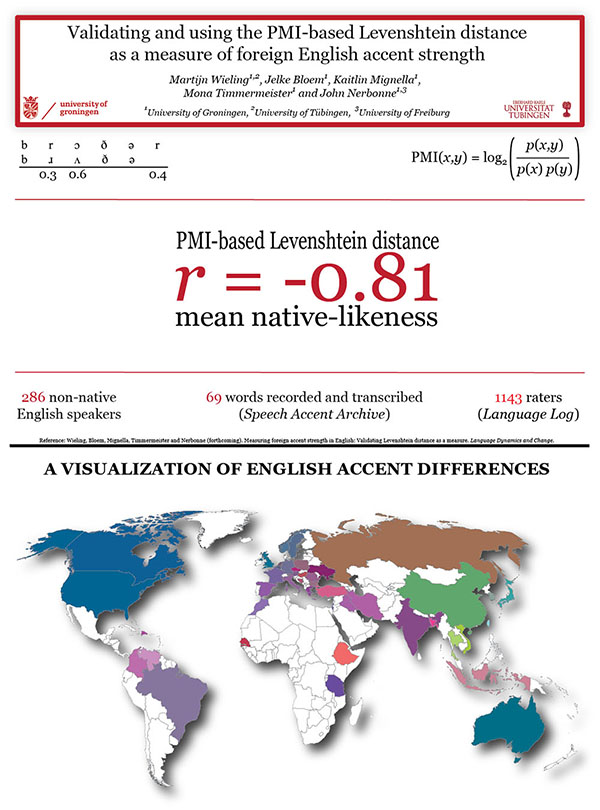
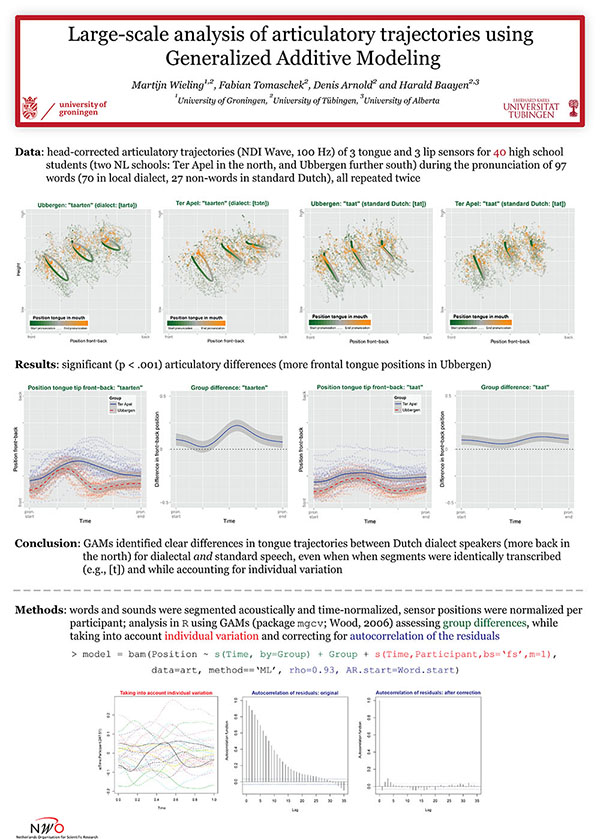
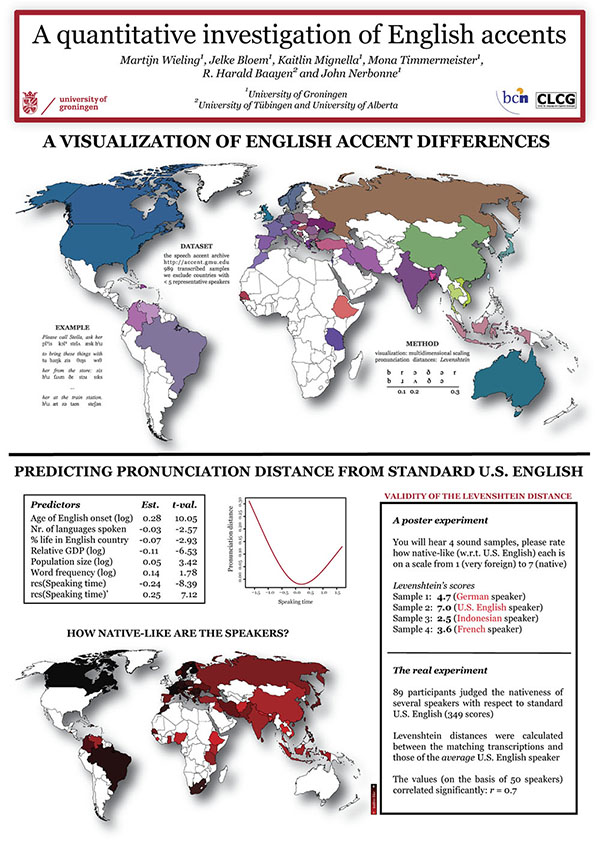
Our board game Streektaalstrijd has launched and after selling out the first edition in only two weeks, the new edition can be purchased at the online shop of the University of Groningen. More information about this board game (in Dutch) can be found via the board game's website www.streektaalstrijd.nl. The launch was covered by various news media, including the Dutch national newspaper De Volkskrant (see News coverage, below).
Our Gronings app 'Van Old noar Jong' has launched and can be freely downloaded for Apple and Android. The app is integrated in a ten-week lesson series about the regional language Gronings for primary schools. Interested schools can order all material (including a copy of De Gruvvalo) for free via the website of the University of Groningen Scholierenacademie. The launch was covered by various news media, including the Dutch national Jeugdjournaal (see News coverage, below).
As of February 2021, we have a mobile laboratory available for our outreach initiatives and conducting research in the field: SPRAAKLAB. See this paper for all specifications. The launch was covered by various news media, including RTV Noord (see News coverage, below). With SPRAAKLAB, we often visit public engagement activities and festivals. For example, we have participated in Noorderzon (2021-2024), Zwarte Cross (2022-2024), and Lowlands (2024).
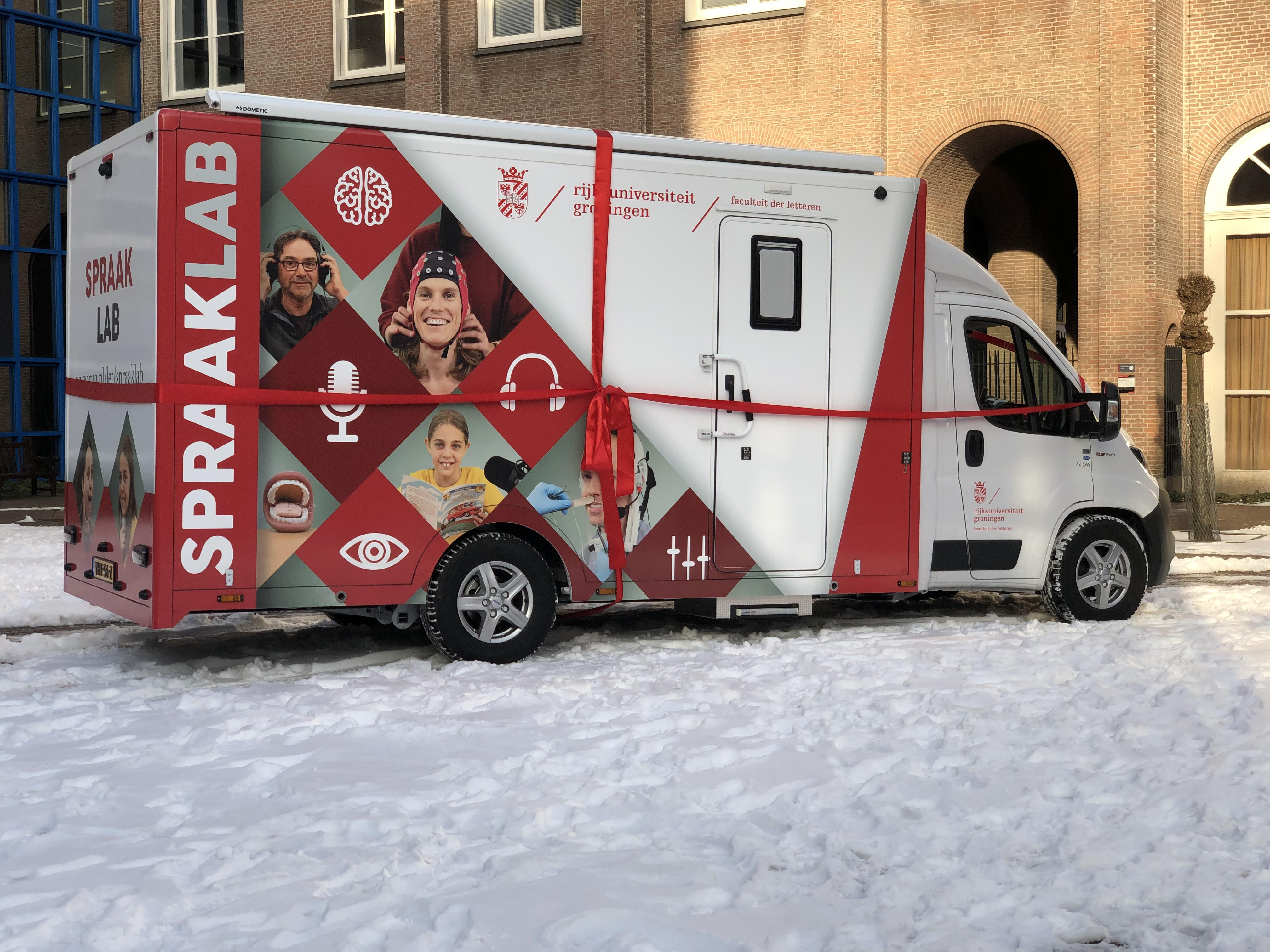
In August 2019, Dr. Gregory Mills and I investigated how language evolves and changes using a interactive game between two players. It was an incredible experience and we were able to collect speech production data for about 75 pairs of speakers during only three days! Our participation was made possible through financial contributions of the University of Groningen, the Young Academy Groningen and the Groningen University Fund. Below you can see an impression of this event. The event was covered by various news media, including NPO Radio 1 (see News coverage, below).
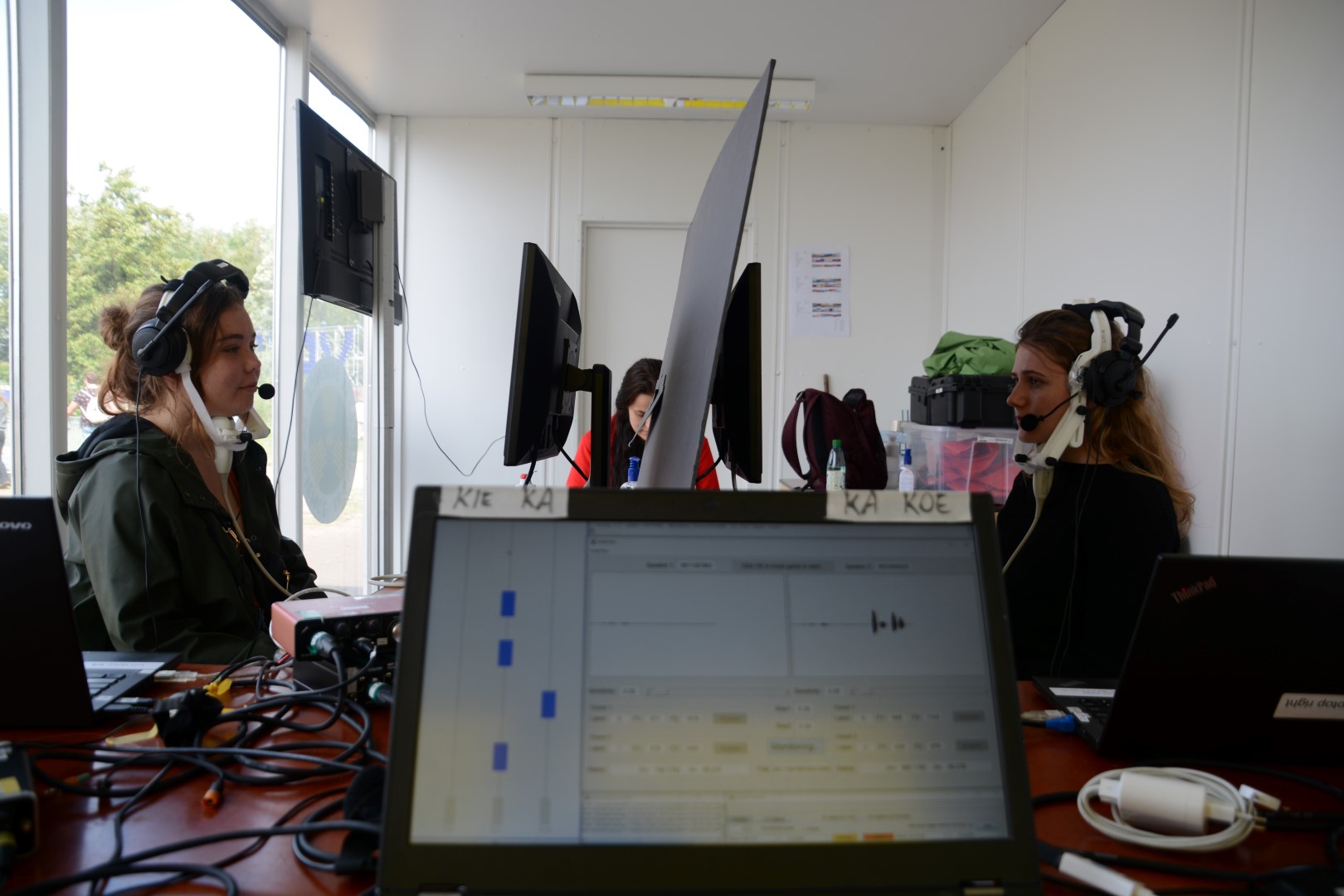
In August 2018, we investigated the influence of alcohol on native and non-native speech using ultrasound tongue imaging. It was an incredible experience and we were able to collect speech production data for about 150 speakers during only three days! Our participation was made possible through financial contributions of the University of Groningen, the Young Academy Groningen and the Groningen University Fund. Below you can see an impression of this event. The event was covered by various national news media, including NPO Radio 1 (see News coverage, below).
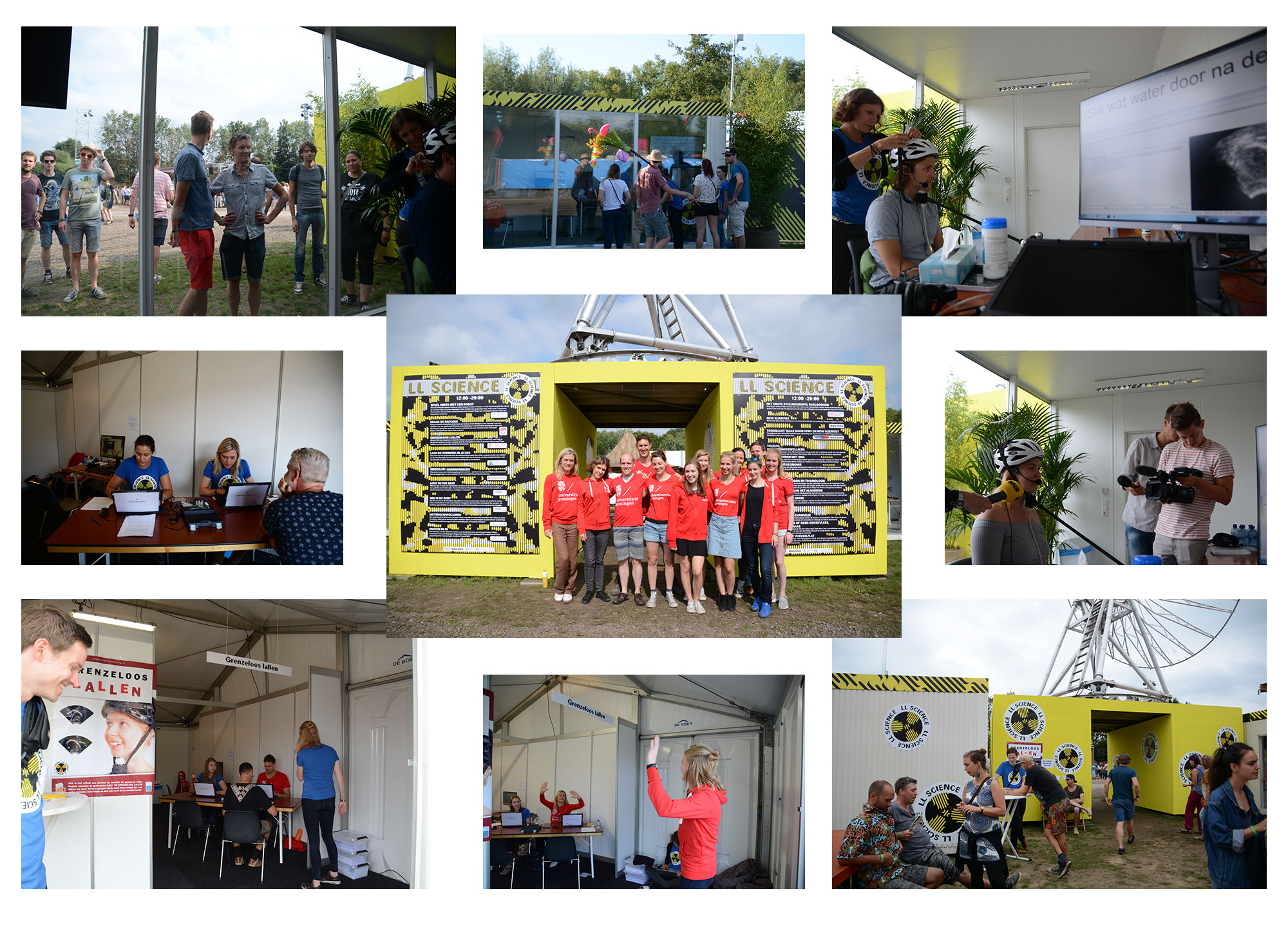
We enjoy demonstrating how we collect data on tongue and lip movement during speech. If you'd like a demonstration at your school or event, please contact me. Below you can see an impression of my team at the Experiment Event for children organized by De Jonge Akademie, the NS, the Spoorwegmuseum, and Quest Junior.
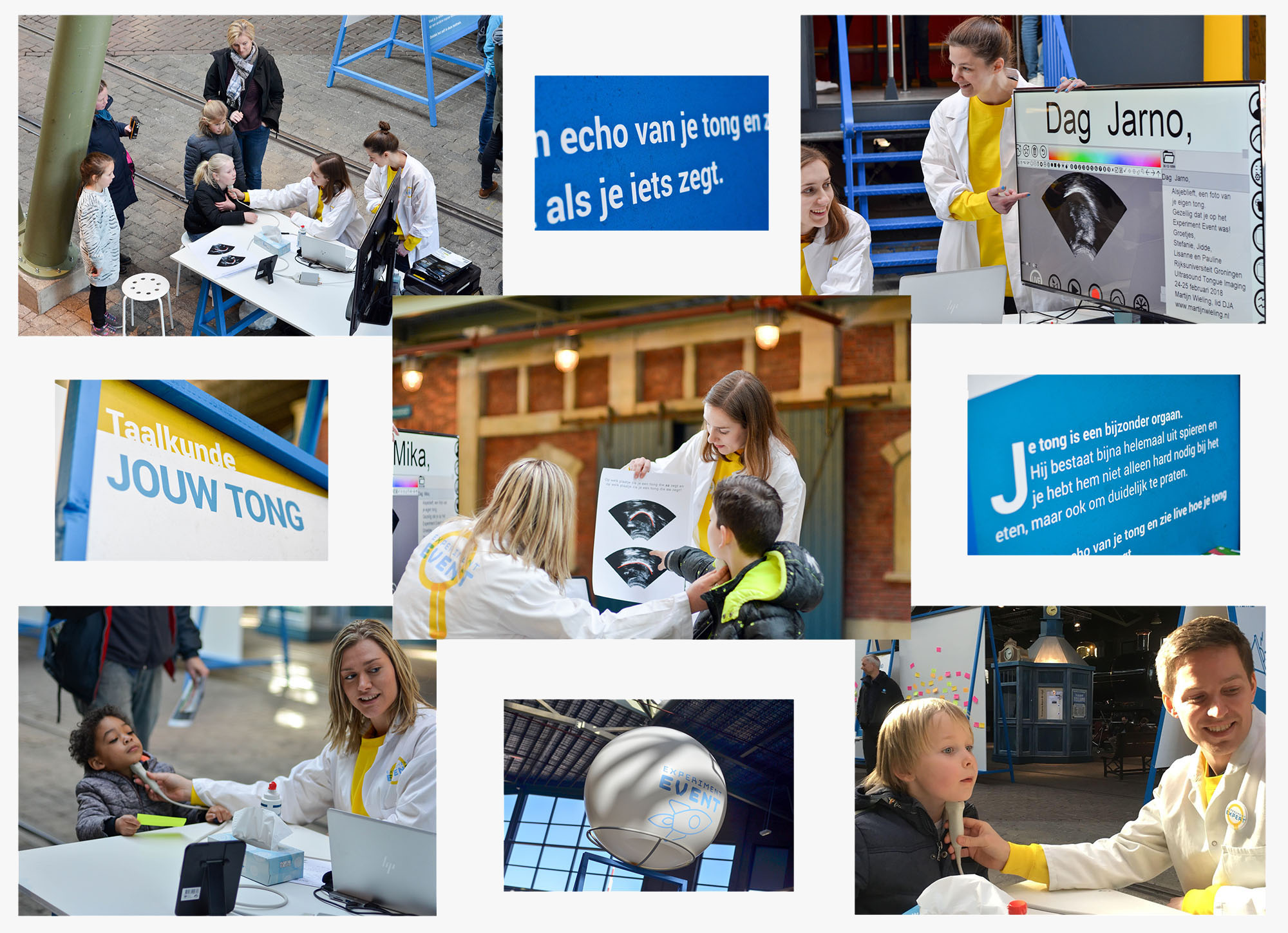
Through a project grant of De Jonge Akademie, I was able to create a comic about my research (designed and drawn by Lorenzo Milito and Ruggero Montalto). You can download it here for free. Please contact me if you would like to receive a printed copy of the Dutch version of the comic (as long as supplies last).
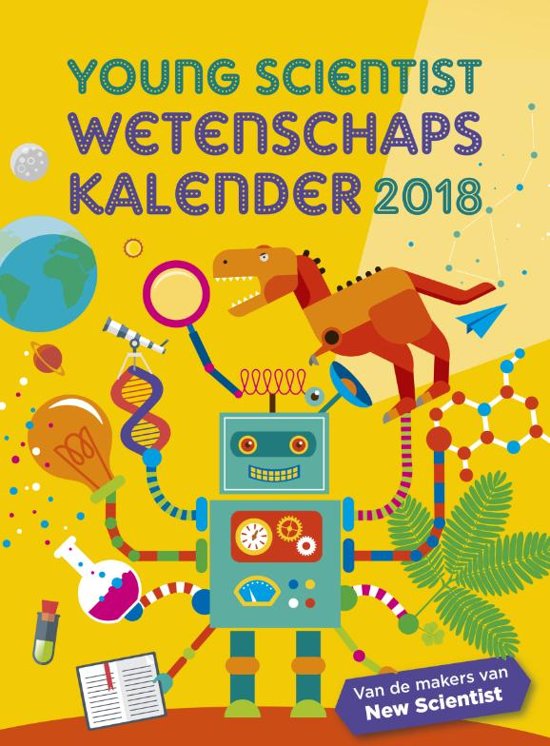
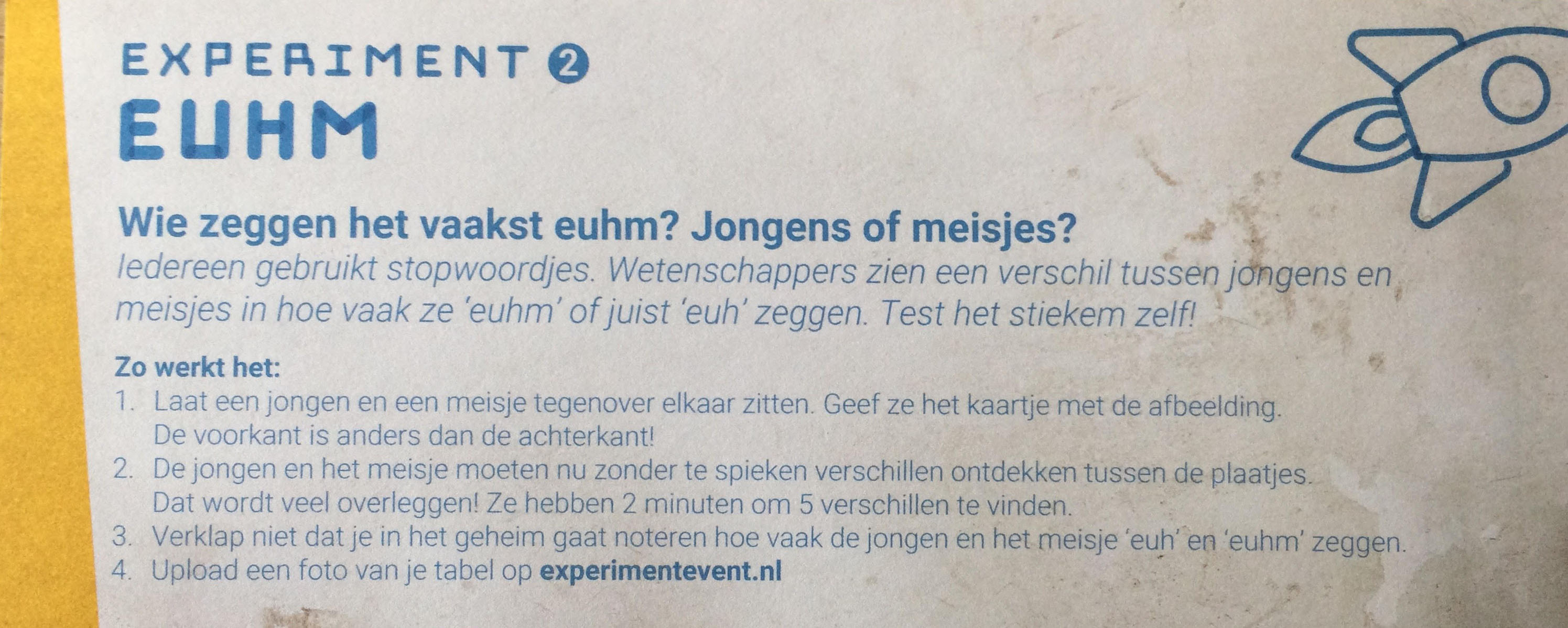
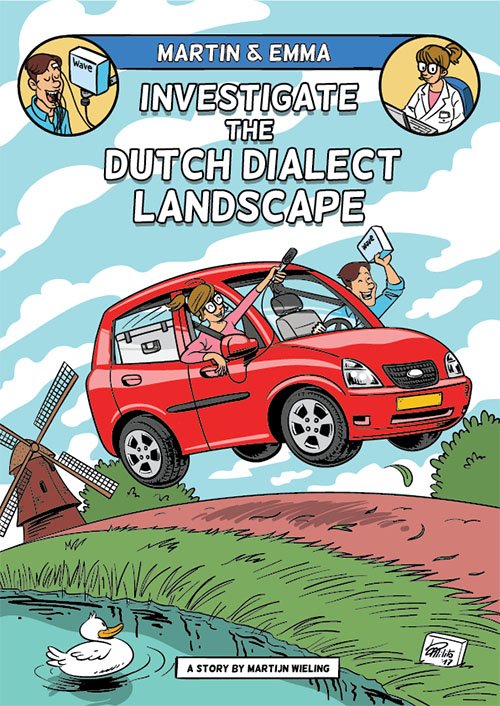
(Note that especially the English news coverage in 2014 got many details wrong, see this Language Log post.)